
Henry Dawson (1811-1878) stands as a significant, if sometimes underappreciated, figure in the rich tapestry of 19th-century British landscape painting. A largely self-taught artist, Dawson's journey from humble beginnings to a respected painter of evocative natural scenes and dramatic maritime subjects is a testament to his innate talent and unwavering dedication. His work, characterized by a profound emotional connection to nature and a masterful handling of light and atmosphere, offers a unique window into the Victorian era's appreciation for the sublime and the picturesque. While influenced by the titans of his time, notably J.M.W. Turner, Dawson forged a distinct artistic identity, leaving behind a legacy of works that continue to captivate with their sincerity and technical skill.
Early Life and Artistic Awakening
Born in Kingston upon Hull on April 3rd, 1811, Henry Dawson's early life was marked by the economic hardships common to many working-class families of the period. His parents, William Dawson and Hannah, soon relocated to Nottingham, a bustling center of the lace industry. It was here, amidst the clatter of machinery, that young Henry was apprenticed as a lace hand. Despite the demanding nature of this work, his artistic inclinations began to surface. The landscapes of Nottinghamshire, with the River Trent and the historic Nottingham Castle, provided early inspiration.
Dawson's passion for art was a powerful driving force. Lacking formal training, he diligently honed his skills through observation and practice. In these nascent stages, his artistic endeavors were a secondary pursuit, a way to supplement his meager income. He reportedly sold small paintings for as little as half a crown each, a modest sum that nonetheless fueled his ambition. These early works, though perhaps unpolished, likely bore the seeds of his later, more accomplished style, demonstrating an inherent sensitivity to the nuances of the natural world. His commitment was such that he would often rise before dawn to sketch, or use his limited leisure time to study the effects of light and weather on the local scenery.
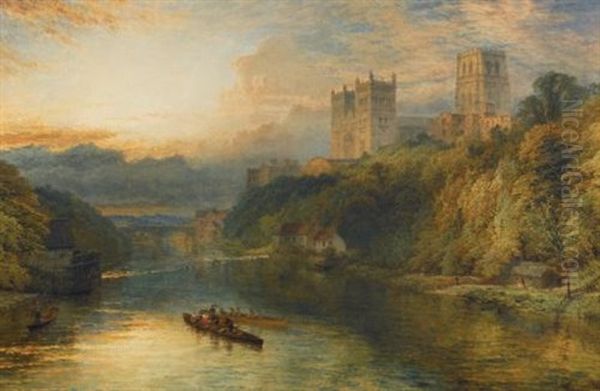
The decision to fully commit to art was a significant gamble. In 1835, at the age of 24, Henry Dawson made the courageous leap, abandoning the relative security of the lace trade to pursue the uncertain path of a professional artist. This was a bold move, indicative of his profound belief in his artistic calling. He married Elizabeth Whittle in the same year, and the responsibilities of a growing family would have added further pressure to succeed in his chosen field. His early patrons were often local, and his subjects frequently drawn from the immediate surroundings of Nottingham and its environs.
Formative Years and Developing Style
The years following his commitment to art were crucial for Dawson's development. He continued to be based in Nottingham for a period, gradually building a local reputation. His artistic vision was expanding, and he sought out new subjects and inspirations. He was an avid student of nature, but also of the art of others. The towering figure of Joseph Mallord William Turner (1775-1851) cast a long shadow over British landscape painting, and Dawson, like many of his contemporaries, was undoubtedly aware of Turner's revolutionary approach to light, color, and atmospheric effects.
While Turner's influence is discernible in Dawson's work, particularly in his more dramatic skies and his fascination with the interplay of light on water, Dawson was no mere imitator. He absorbed lessons from the master but filtered them through his own sensibilities, developing a style that was uniquely his. His early landscapes often possess a quiet, pastoral charm, reflecting the influence of earlier British landscape traditions, perhaps even echoing the work of artists like John Constable (1776-1837) in their honest depiction of rural England, though Dawson's palette and handling would evolve distinctly.
In 1844, seeking broader opportunities and a more stimulating artistic environment, Dawson moved his family to Liverpool. This port city, with its bustling maritime activity and proximity to the dramatic coastlines of North Wales and the Lake District, offered fresh inspiration. His time in Liverpool saw his work gain greater maturity and his reputation begin to extend beyond his native Nottinghamshire. He exhibited at the Liverpool Academy and other regional venues, gradually attracting the attention of collectors and critics. His subjects during this period often included coastal scenes, shipping, and the varied landscapes of northern England.
Artistic Themes and Subject Matter
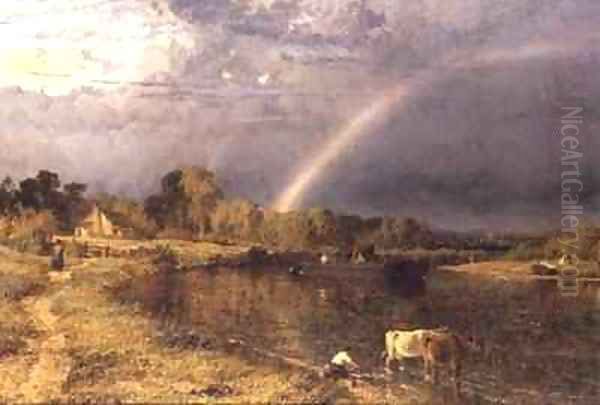
Henry Dawson's oeuvre is predominantly focused on landscape and marine subjects. He possessed a deep and abiding love for the British Isles, and his paintings celebrate its diverse beauty, from tranquil river valleys to rugged coastlines and bustling cityscapes. A recurring theme in his work is the depiction of water, whether it be the calm expanse of a lake, the flowing current of a river, or the dramatic surge of the sea. He was particularly adept at capturing the reflective qualities of water and the way it interacts with light.
His paintings often feature prominent architectural elements, such as cathedrals, castles, and bridges, which serve not merely as topographical markers but as integral components of the composition, imbued with historical and romantic resonance. Works depicting Durham Cathedral, for instance, showcase his ability to integrate majestic architecture into a sweeping natural setting, emphasizing its grandeur against the backdrop of sky and river. Similarly, his many views of Nottingham Castle and the River Trent demonstrate a long-standing connection to his formative environment, often rendered with a palpable sense of place.
Dawson was also a keen observer of atmospheric conditions. His skies are rarely passive backdrops; they are dynamic elements, full of movement, light, and color. He excelled at depicting sunsets and sunrises, storms, and the ethereal effects of mist and haze. This sensitivity to atmosphere lends his paintings a strong emotional charge, evoking moods ranging from serene contemplation to dramatic intensity. His marine paintings, in particular, often capture the power and majesty of the sea, with ships battling a gale or riding calmly at anchor under a luminous sky. Figures, when they appear, are generally small in scale, serving to emphasize the grandeur of nature or to provide a narrative focal point within the broader scene.
Key Representative Works
Several paintings stand out as representative of Henry Dawson's artistic achievements and stylistic characteristics. While a comprehensive list is extensive, certain works are frequently cited and admired.
The Wooden Walls of Old England is one such iconic piece, showcasing his skill in marine painting and his patriotic sentiment. This work, depicting majestic sailing ships, evokes a sense of national pride and maritime heritage, rendered with impressive detail and a dramatic use of light. The title itself harks back to a time when Britain's naval power was paramount.
His depictions of Durham Cathedral are notable for their grandeur and atmospheric depth. These paintings often capture the cathedral perched high above the River Wear, its imposing silhouette set against a carefully rendered sky. Dawson masterfully conveys the sense of scale and the interplay of light on the ancient stone and the surrounding landscape.
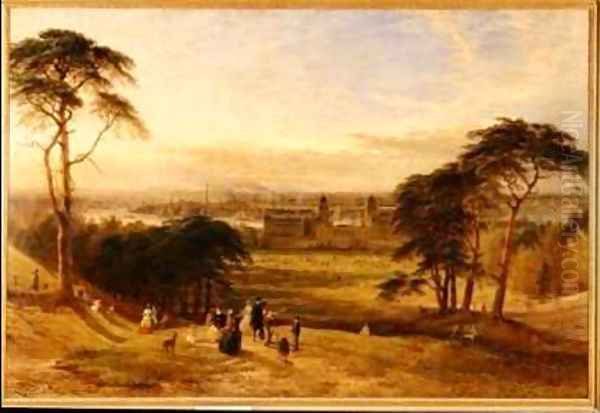
Views of Nottingham from Trent Bridge or featuring Nottingham Castle are numerous and reflect his deep connection to the city. These works often combine topographical accuracy with a picturesque sensibility, capturing the life of the river and the historic presence of the castle. One notable example is Nottingham Castle on Fire, October 10th, 1831, a dramatic historical scene.
The Rainbow is a subject that allowed Dawson to explore the transient beauty of light and color. Such paintings demonstrate his ability to capture fleeting natural phenomena with both accuracy and poetic feeling. The symbolism of the rainbow, often associated with hope and divine promise, would have resonated with Victorian audiences.
His London scenes, such as London from Greenwich Hill or views of The Houses of Parliament, show his capacity to tackle complex urban landscapes. These works often feature a panoramic scope, capturing the sprawling metropolis under varying light conditions, sometimes with a smoky, industrial haze, other times with the clear light of dawn or dusk. St. Paul's from Southwark Bridge is another example of his London views.
Other significant titles include Guardship at Sunset, Men-of-War and a Blazing Sunset: The Guardship, View in Dove Dale, Derbyshire, The English Lakes, Before the Storm, Brent Knoll, The Cow Pasture, Coast Scene, Evening, Coast Scene, Sunset, Coast Scene with a Jetty, and The Cutting Out of the "Hermione". These titles alone suggest the breadth of his subject matter, encompassing tranquil pastoral scenes, dramatic coastal views, and specific historical or notable locations.
Exhibitions and Recognition
Despite his considerable talent, Henry Dawson's path to widespread recognition was a gradual one. He was a consistent exhibitor throughout his career, sending works to major London institutions such as the Royal Academy, the British Institution, and the Society of British Artists. His first painting exhibited at the Royal Academy was View of Nottingham from Wilford Grove in 1838. He continued to exhibit there sporadically, with notable works including The New Houses of Parliament (1853) and London from Greenwich Hill (1854).
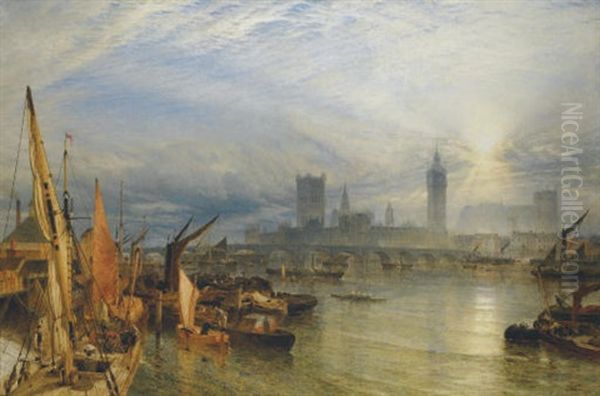
His participation in regional exhibitions, particularly in Liverpool and Nottingham, was also important. He was associated with the Nottingham Society of Artists. However, for much of his career, Dawson did not achieve the level of fame or financial success enjoyed by some of his more celebrated contemporaries. This may have been due in part to his self-taught background, his residence outside of London for significant periods, or perhaps a style that, while accomplished, did not always align with the prevailing tastes of the London art establishment at certain times. Artists like Edwin Landseer (1802-1873), with his popular animal paintings, or members of the Pre-Raphaelite Brotherhood such as John Everett Millais (1829-1896) and William Holman Hunt (1827-1910), who caused a stir with their detailed realism and symbolic content, often captured more public and critical attention.
It was relatively late in his life that Dawson's work began to command higher prices and receive more significant acclaim. A turning point came with the Nottingham Museum and Art Gallery's exhibition of his works in 1878, the year of his death. This exhibition, a comprehensive survey of his career, brought his achievements to a wider public and solidified his reputation, particularly in his adopted home region. It highlighted the consistency of his vision and the technical mastery he had developed over decades of dedicated work. The prices for his paintings, which had been modest for many years, began to rise significantly towards the end of his life and posthumously.
The Victorian Art World: Context and Contemporaries
Henry Dawson worked during a vibrant and transformative period in British art. The Victorian era saw a burgeoning middle class with an increased appetite for art, leading to a growth in galleries, exhibitions, and art societies. Landscape painting was particularly popular, reflecting a romantic appreciation for nature, a sense of national identity tied to the British countryside, and perhaps an escape from the increasing industrialization of urban centers.
Dawson's contemporaries in landscape and marine painting were numerous and varied. Besides the towering influence of Turner and the enduring legacy of Constable, artists like David Cox (1783-1859) and Peter De Wint (1784-1849) were known for their fresh, direct watercolour landscapes. Clarkson Stanfield (1793-1867) was a highly successful painter of marine subjects and dramatic landscapes, often with a theatrical flair, and David Roberts (1796-1864) was renowned for his topographical views of Britain, Europe, and the Near East.
John Linnell (1792-1882) produced rich, detailed landscapes, often with a pastoral or biblical theme. Samuel Palmer (1805-1881), though an artist of a very different, more visionary temperament, was also a contemporary whose intense, poetic landscapes of Shoreham offered a unique counterpoint to more conventional views. Later in Dawson's career, artists like Benjamin Williams Leader (1831-1923) gained immense popularity with their highly finished, picturesque views of the British countryside, particularly Worcestershire and Wales. Marine painters such as James Clarke Hook (1819-1907), known for his lively coastal scenes with figures, also shared some thematic territory with Dawson.
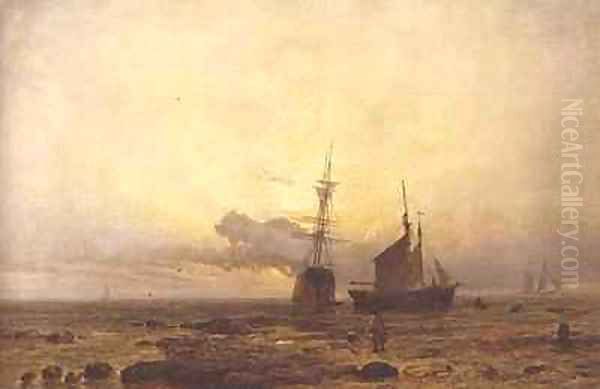
While Dawson may not have been part of a specific "school" or movement in the way the Pre-Raphaelites were, his work fits broadly within the romantic and realist traditions of British landscape painting. He shared with many of his contemporaries a commitment to observing nature closely, yet he also imbued his scenes with a personal, often poetic, interpretation. His focus on atmospheric effects and the sublime aspects of nature connected him to the Romantic lineage, while his careful rendering of specific locations and details aligned with the Victorian appreciation for verisimilitude.
It is important to note that the "controversy" sometimes associated with a "Henry Dawson" regarding a pension application in the United States almost certainly refers to a different individual. The painter Henry Dawson (1811-1878) spent his career in England, and his life and work are well-documented within the British art historical context. Similarly, any mention of a "rebellious style" in relation to artistic controversy likely misattributes events or characteristics of other artists, perhaps even other artists named Dawson from different periods or countries, such as the American modernist Manierre Dawson (1887-1969). Henry Dawson the British landscapist was known for his originality within the landscape tradition, not for overt rebellion against artistic norms in a controversial sense.
Later Life, Legacy, and Influence
In 1849 or 1850, Henry Dawson moved from Liverpool to London, eventually settling in Chiswick, where he spent the remainder of his life. This move to the capital placed him closer to the center of the British art world, though he continued to travel for subject matter. His later works often display an even greater command of complex compositions and luminous effects, sometimes striving for, as one source notes, "more brilliant effects," perhaps reflecting a continued engagement with Turner's late style or simply his own evolving artistic ambitions.
Henry Dawson passed away in Chiswick, London, on December 13th, 1878, at the age of 67. He was buried in Brompton Cemetery. He left behind a significant body of work, now held in numerous public and private collections, including the Nottingham Castle Museum and Art Gallery, the Tate Britain, and the Victoria and Albert Museum.

His artistic legacy was continued to some extent by his sons. Alfred Dawson (1843-1931) became a noted engraver and also painted, while Henry Isaac Dawson (1841-c.1918), also known as Henry Thomas Dawson Jr., was a painter of marine and coastal scenes, clearly influenced by his father. However, it was his grandson, Montague Dawson (1890-1973), who achieved international fame as one of the 20th century's foremost marine painters. Montague Dawson undoubtedly inherited a passion for the sea and for meticulous depiction from his grandfather, though his style evolved to become more polished and focused on the dynamic portrayal of sailing ships in action, appealing to a different generation of collectors. The foundational interest in maritime subjects and atmospheric conditions, however, can be seen as a familial artistic through-line.
Henry Dawson's broader influence on subsequent landscape painters is perhaps more diffuse than direct. He was not a teacher in a formal academy, nor did he establish a distinct "school" of followers. However, his dedication to capturing the specific character of the British landscape, his mastery of light and atmosphere, and his ability to convey emotion through natural scenery contribute to the rich continuum of British landscape art. His work serves as an example of how a self-taught artist, through perseverance and innate talent, could achieve a significant and lasting artistic voice.
Conclusion: An Enduring Vision
Henry Dawson's art offers a compelling vision of 19th-century Britain. His landscapes and seascapes are more than mere topographical records; they are imbued with a sense of wonder, a deep appreciation for the beauty and power of nature, and a subtle romanticism. From the tranquil rivers of Nottinghamshire to the dramatic coasts and the bustling Thames, Dawson captured the essence of his environment with a skilled hand and a poet's eye.
Though he may have waited long for widespread recognition, the quality of his work has endured. He navigated the influences of giants like Turner while cultivating his own distinct style, characterized by its luminous skies, careful attention to detail, and evocative moods. As an artist who rose from humble beginnings to create a significant body of work, Henry Dawson remains an important figure for those who appreciate the enduring allure of British landscape painting and the dedication of a life devoted to art. His paintings continue to speak to us, offering moments of beauty, drama, and quiet contemplation, securing his place in the annals of art history.